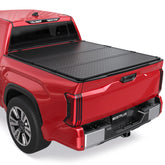4 Questions You Need to Know Before Buying LED Headlights?
We know what specs to look for when buying a car: low mileage, high MPG, horsepower and torque. But what about your headlights? What are the most important specifications for LED headlights? This is the most frequently asked question by customers shopping for LED headlights.
What factors affect brightness?
Brightness for LED headlights refers not only to how much light a bulb emits, but how much of that total light contributes to safer driving. Two common units for measuring light are lumen and lux. You can think of lumens as the total weight of a table, and lux as the weight of the single spot under one of its many legs.
How do we find total lumens and lux for LED headlight bulbs?
Total lumens is widely used by manufacturers during LED bulb design and is often measured by an integrating sphere after the bulb is made. We can also get the total lumens even before the bulb is made during its design by using this formula: total lumens = luminous efficacy × power.

What is the light output?
Lumen output is lumens per watt. Luminous efficacy is one of the most important metrics for LED chips. The most efficient and affordable LED bulbs have an efficacy of 200 lumens per watt. But when it comes to LED headlights, it's not just about total brightness. There is a unique factor called beam pattern that makes this industry different and hard to move forward without cutting edge LED technology.
There are many different high-efficiency LED chips out there, so why don't headlight bulbs just use a 200 lumens per watt high-efficiency LED chip? Most of them cannot be used in LED headlights due to the safety concerns of road lighting, which is regulated by the DOT.
What is the efficiency of LED headlight bulbs?
Many LED headlights on the market use LED chips with an efficacy of less than 100 lumens per watt. The highest efficacy headlight bulb in our product line is up to 138.8 lumens per watt.
So how do you figure out the total lumens of an LED bulb? Let's make it simple. If we start with an efficacy of 100 lumens per watt and you have an LED headlight bulb that consumes 40 watts, then you can expect 4000 lumens.
Why not add more power to a bulb to increase brightness?
It's simple - LED chips do not take heat well. The average power consumption of an LED headlight bulb is very limited, usually between 15 watts and 45 watts before it gets too hot and burns out.
Knowing this, you cannot be fooled by an advertisement like this: 630,000 lumens, which is more than 10 times the lumens of a typical LED headlight bulb, divided by 4200 watts, which is 100 times more than a typical LED headlight bulb, equals 150 lumens per watt, which is a very good efficiency. However, it is uncommon in low-end LED headlights.
Featured Products
- $479.99
$499.99- $479.99
- Unit price
- / per
- $549.99
$549.99- $549.99
- Unit price
- / per
- $489.99
- $489.99
- Unit price
- / per
- $469.99
$489.67- $469.99
- Unit price
- / per














